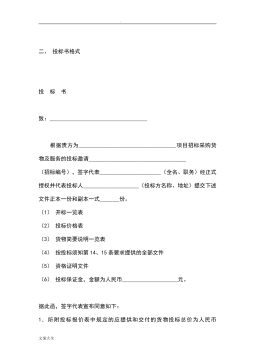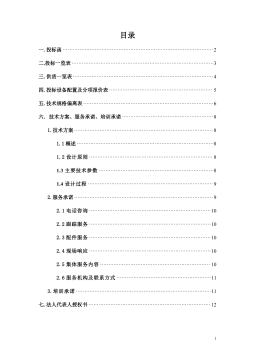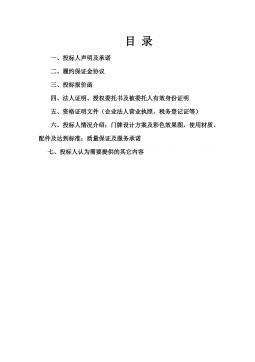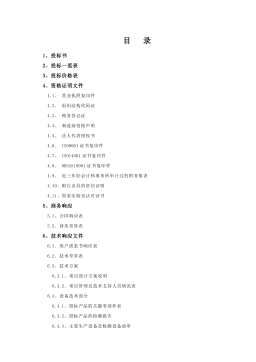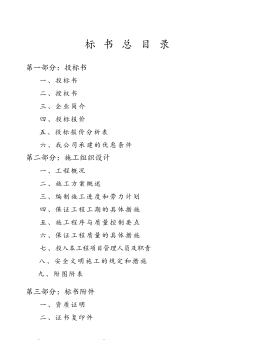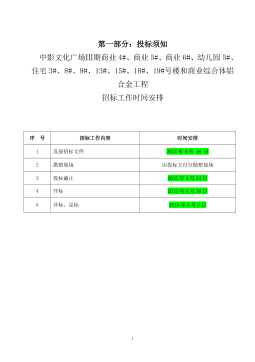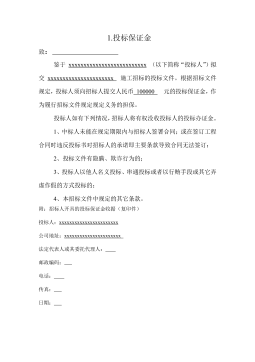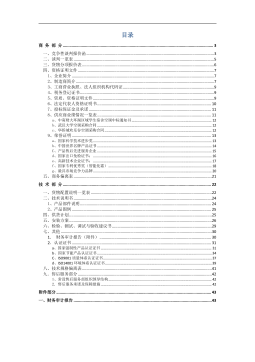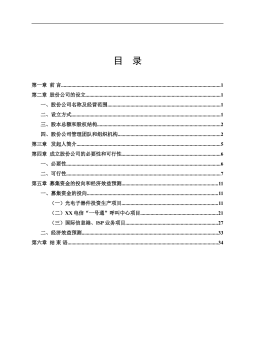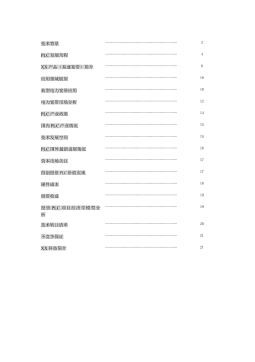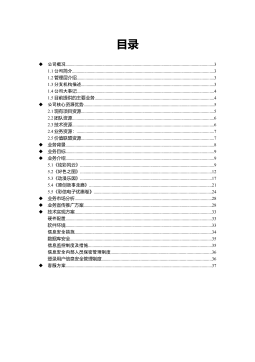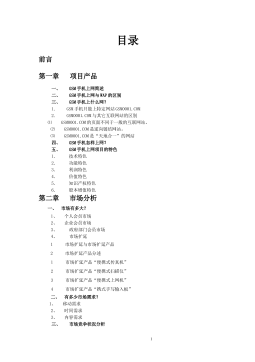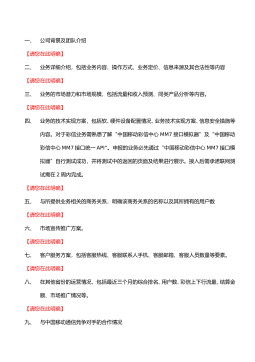挤压型纤维复合水泥墙板的配合比试验研究
VIP免费
挤压型纤维复合水泥墙板的配合比
试验研究
摘 要
针对挤压型纤维复合水泥墙板的发展需求,本文研究了粉煤灰及多种纤维对
水泥砂浆的增强作用,探讨了纤维复合水泥在不同材料配合比下的力学性能及其
变化特性,并通过纤维水泥的抗弯试验,研究了纤维水泥的韧性,对比分析了各
材料对水泥砂浆力学性能的影响规律。具体的研究内容如下:
(1)为研究絮状纤维素纤维和单丝合成纤维对水泥砂浆强度的影响规律,
进行了纤维水泥的强度试验。结果表明:两种纤维对水泥砂浆的增强效果基本一
致,纤维水泥强度均随着纤维掺量的增加先增大后减小;当絮状纤维素纤维掺量
为0.3%时,纤维水泥强度达到最大值;当单丝合成纤维纤维掺量为 0.2%时,单
丝合成纤维增强水泥有最大强度值;单丝合成纤维增强水泥最大强度高于絮状纤
维素纤维增强水泥,但试件受力破坏过程中强度下降均较快。
(2)研究了粉煤灰、单丝合成纤维和废纸纤维对纤维复合水泥强度的影响程
度及其规律。选用三因素三水平正交设计法及其补充试验优化纤维复合水泥最优
配合比,得出如下结论:最终影响纤维复合水泥强度的主次因素顺序依次为:水
泥/粉煤灰掺量、单丝合成纤维掺量、废纸纤维掺量;综合考虑试验结果及经济因
素最终确定,纤维复合水泥强度最大配合比:水泥掺量 28%、粉煤灰掺量 32%、废
纸纤维掺量 2.6%、单丝合成纤维 0.16%,经济最优配合比:水泥掺量 24%、粉煤灰
掺量 36%、废纸纤维掺量 2.6%、单丝合成纤维 0.16%;由试验分析得出以下规律:
纤维复合水泥强度随着粉煤灰和废纸纤维掺量的增加呈现降低趋势,随着单丝合
成纤维掺量的增加而增大。
(3)结合纤维复合水泥最优配合比进行抗折试验,并用折压比简单分析纤
维复合水泥的韧性。根据试验结果得到如下结论:当水泥掺量一定时,单丝合成
纤维掺量为 0.16%的纤维复合水泥抗折强度有最大值,但水泥掺量为 28%的纤维
复合水泥抗折强度高于水泥掺量为 24%的纤维复合水泥;当纤维复合水泥中水泥
掺量一定时,试件抗压强度、抗折强度均随着单丝合成纤维掺量的增加而增大,
但试件抗折强度增长较慢,故试件折压比随着单丝合成纤维掺量的增加而降低;
当纤维掺量相同时,水泥掺量为 28%的纤维复合水泥的折压比低于水泥掺量为
24%纤维复合水泥;随着单丝合成纤维掺量的增加,试件折压比呈现下降趋势,
且水泥掺量为 28%的纤维复合水泥折压比下降较快。
(4)为模拟挤压型墙板的挤压工艺,发明了墙板挤压模具并应用于挤压墙
板试件的抗弯试验研究。设计了挤压墙板专用的模拟挤压工艺的墙板挤压试件模
具,并取得了授权实用新型专利,使得挤压型水泥墙板的实验室研究可以不借助
昂贵的挤压机也能实现,为挤压墙板的发展研究提供了有利条件。利用墙板挤压
模具制作挤压型墙板试件进行了抗弯试验研究,得到如下结论:水泥掺量为 24%
的挤压型纤维复合水泥墙板的抗弯强度是水泥掺量为 28%的试验组试件的 1.5 倍;
挤压型纤维复合水泥墙板抗弯强度变化规律与用纤维复合水泥折压比分析纤维复
合水泥的韧性变化规律基本一致,两种纤维增强水泥抗弯强度均低于 3MPa。
(5)采用美国 ASTM C1018 混凝土韧性分析理论研究方法进行纤维水泥的
韧性分析。首先介绍了四种国际常用的韧性分析理论,根据韧性分析理论进行纤
维水泥韧性试验分析,得到如下结果:纤维水泥抗弯强度值随纤维掺量的增加而
降低,但纤维水泥的抗弯强度始终高于 5MPa;纤维水泥抗弯强度与墙板试件的
抗弯强度相比,明显得到了提高;通过韧性分析可得,纤维水泥剩余强度因子变
化趋势与纤维水泥抗弯强度变化趋势基本一致,即随着纤维掺量的增加而减小;
单丝合成纤维对水泥砂浆起到了明显的增韧作用,单丝合成纤维对水泥砂浆的韧
性指数影响效果最大为素混凝土的 4.9 倍,材料的剩余强度因子也从 2.8 增大到
6.1。由此可知,纤维可以明显增加水泥砂浆的韧性。
关键词:挤压型墙板 纤维水泥 纤维素纤维 废纸纤维 粉煤灰 韧性测试
ABSTRACT
Aiming to meet the development demand of wallboard, this thesis has not only
studied reinforcement effects of additive materials, including fly ash and a variety of
fibers, on cement mortar, but also discussed mechanical properties of the fiber
reinforced cement composite with various mixture proportions as well as their varying
patterns. Based on bending test for fiber reinforced cements, the resiliencies of them
are well analyzed and influence of many kinds of materials on mechanical properties
of cement mortar are compared. The main research work in this thesis is given as
follows.
(1) Compressive testing for fiber reinforced cement has been conducted to
explore the compressive strength variation of the cement mortar, in which flocculent
cellulose fiber and monofilament synthetic fiber are adopted as enhancer, respectively.
Results indicate both fiber reinforced cement mortar are the same effect basically, the
specimen strength with increasing fiber content were decreases; when the floc
cellulose fiber content of 0.3%, the fiber cement strength reaches a maximum; when
the monofilament synthetic fiber content of 0.2%, the monofilament synthetic fiber
reinforced cement maximum intensity value; monofilament synthetic fiber reinforced
cement intensity is higher than the maximum floc cellulose fiber reinforced cement,
but the specimen by the force of destruction process strength decreases were faster.
(2) Influence of three types of additives, such as fly ash, monofilament synthetic
fiber and waste paper fiber, on the strength of fiber cement composites are roundly
scrutinized. Based on three factors and three levels orthogonal design method as well
as supplementary test to optimize the mixture ratio of fiber cement composite,
priorities of elements that finally determine the strength of fiber cement composites
are given as follows: cement/fly ash, monofilament synthetic fiber, waste paper fiber.
Considering the experimental results and societal economy, the mix proportion for
maximum strength is determined as cement (28 percent), fly ash (32 percent), waste
paper fiber (2.6 percent) and monofilament synthetic fiber (0.16 percent). But the mix
proportion changes to cement (24 percent), fly ash (36 percent), waste paper fiber (2.6
percent) and monofilament synthetic fiber (0.16 percent) when the economy is
emphatically considered. Through experimental results analysis, it is concluded that
while the strength of fiber cement composites shows a trend of decline with the
increase of fly ash and waste paper fiber, the strength improves along with the
addition of monofilament synthetic fiber.
(3) Based on the optimal mixture proportion above, flexural strength test for fiber
cement composites has been carried out, in which ratio of compressive strength is
employed to analyze its roughness in simplicity. According to the experimental
results, following conclusions have been obtained: 0.16 percent monofilament
synthetic fiber mixed enables fiber reinforced cement a maximum flexural strength
when cement is constant, but the 28 percent cement added corresponding to a higher
flexural strength than 24 percent cement. In addition, although compressive and
flexural strengths both decrease with the increase of monofilament synthetic fiber
when cement is constant, flexural strength increases at a low speed, therefore ratio of
compressive strength declines along with monofilament synthetic fiber. The ratio of
compressive strength corresponding to 28 percent cement is lower than that
corresponding to 24 percent cement when fiber is constant. In addition, ratio of
compressive strength descends with a increase of monofilament synthetic fiber,
especially block containing 28 percent cement experiences a faster decline with
respect to ratio of compressive strength.
(4) To simulate extruding technique, extrusion mold has been developed and
applied in the flexural experimental analysis of compressive wallboard. The
mentioned has been patented, and by this mold, the bench-scale experiment could
detach restraint of expensive extruding machine, providing a favorable condition for
the development of the extruding wallboard. On the basis of flexural testing for
extruding fiber reinforced composites wallboard using the developed mold, it is
concluded that flexural strength of wallboards with 24 percent cement is higher than
that of wallboards with 28 percent cement. The changes of flexural strength of
extruding fiber reinforced composites wallboard is basically same as the above
analysis related to roughness fiber reinforced cement adopting ratio of compressive
strength method. By these two methods in flexural strength testing, it is knowable that
the flexural strengths of specimens are all below 3 MPa.
(5) Roughness of fiber reinforced cement has been analyzed by theoretical
research method for concrete roughness provided in the American standard numbered
ASTM C1018. Firstly, four common used international methods for roughness
analysis are introduced and results from fiber cement toughness test are obtained as
follows: flexural strength of fiber reinforced cement blocks increases along with the
amount of fiber with minimum value no less than 5 MPa. Compared with the flexural
strength obtained from above methods, the flexural strength gained from this method
has been clearly improved. Meanwhile, residual strength index of fiber reinforced
cement share a basically same trend with flexural strength, that is to say, it decreases
with the increase of fiber. Compared with other fragile materials, monofilament
synthetic fiber has obviously enhanced the roughness of cement mortar, which is
shown in the following aspects: roughness index ranges from 2.46 to 4.9 and residual
strength index increases from 2.8 to 6.1. In conclusion, fiber could greatly improve the
roughness of the cement mortar.
Key word: Wall of extruding technique, Fiber reinforced cement, Cellulosic fiber,
Waste paper fiber, Fly ash, Toughness testing
目 录
摘 要
ABSTRACT
第一章 绪 论.....................................................................................................................1
1.1 纤维水泥的研究现状..........................................................................................1
1.2 粉煤灰资源化利用现状......................................................................................3
1.3 挤压型墙板的研究现状......................................................................................4
1.4 挤压型纤维复合水泥墙板研究现状..................................................................6
1.5 问题的提出..........................................................................................................7
1.6 研究内容..............................................................................................................8
第二章 纤维水泥抗压强度测试......................................................................................9
2. 1 原材料、试验设备及方法.................................................................................9
2.1.1 试验设备及原材料....................................................................................9
2.1.2 纤维水泥试件的制作..............................................................................10
2.1.3 试验过程..................................................................................................11
2.2 试验结果及数据整理........................................................................................12
2.2.1 立方体强度计算理论..............................................................................12
2.2.2 强度试验数据整理..................................................................................12
2.3 纤维水泥强度变化规律分析............................................................................13
2.3.1 纤维水泥早期强度随纤维掺量的变化..................................................13
2.3.2 纤维水泥后期强度随纤维掺量的变化..................................................13
2.3.3 两种纤维水泥强度对比..........................................................................14
2.4 本章小结............................................................................................................15
第三章 纤维复合水泥配合比试验与分析....................................................................16
3.1 试验材料性能介绍............................................................................................16
3.2 多因素影响的纤维复合水泥正交设计............................................................17
3.2.1 正交试验设计方案..................................................................................17
3.2.2 纤维复合水泥试件的制作......................................................................18
3.2.3 纤维复合水泥强度试验..........................................................................18
3.2.4 纤维复合水泥强度试验分析..................................................................18
3.3 试验影响因素分析............................................................................................21
3.3.1 粉煤灰对纤维水泥强度影响分析..........................................................21
3.3.2 单丝合成纤维和废纸纤维对水泥砂浆强度影响分析..........................22
3.4 本章小结............................................................................................................22
第四章 用折压比进行纤维复合水泥韧性分析............................................................24
4.1 纤维复合水泥抗折试验....................................................................................24
4.1.1 试验方案设计..........................................................................................24
4.1.2 纤维复合水泥试件的制作......................................................................24
4.1.3 纤维复合水泥抗折试验..........................................................................25
4.1.4 抗折试验分析..........................................................................................26
4.2 用折压比分析纤维复合水泥韧性....................................................................27
4.2.1 试验数据整理..........................................................................................27
4.2.2 纤维复合水泥折压比分析......................................................................27
4.2.3 折压比分析韧性的优点..........................................................................28
第五章 挤压型墙板成型试件模具的研制及其抗弯试验............................................30
5.1 国内外挤压工艺的发展....................................................................................30
5.2 挤压模具的研制及其优点................................................................................32
5.2.1 模具的研制..............................................................................................32
5.2.2 模具优点..................................................................................................33
5.3 挤压型纤维复合水泥墙板抗弯试验................................................................33
5.3.1 试验设备及原材料..................................................................................33
5.3.2 挤压墙板试件制作..................................................................................33
5.4 挤压型纤维复合水泥墙板抗弯性能分析........................................................35
5.4.1 挤压墙板三点弯曲试验..........................................................................35
5.4.2 测试结果及分析......................................................................................36
5.5 本章小结............................................................................................................36
第六章 纤维水泥的韧性测试研究................................................................................38
6.1 韧性计算理论....................................................................................................38
6.1.1 美国 ASTM- C1018 方法.........................................................................38
6.1.2 日本JSCE 方法........................................................................................39
6.1.3 挪威 NBP NO7 方法................................................................................40
6.2 纤维水泥韧性分析试验....................................................................................40
6.2.1 试验设备及原材料..................................................................................40
6.2.2 纤维水泥配合比设计与试件制作..........................................................41
6.3 纤维水泥弯曲韧性试验研究............................................................................42
6.3.1 纤维水泥三点弯曲试验..........................................................................42
6.3.2 试验数据整理分析..................................................................................45
6.3.3 测试结果及理论分析..............................................................................45
6.4 尺寸效应对纤维水泥板韧性的影响分析........................................................47
6.4.1 链条假设理论..........................................................................................47
6.4.2 理论修正..................................................................................................49
6.5 本章小结............................................................................................................51
第七章 结论与展望........................................................................................................52
7.1 结论....................................................................................................................52
7.2 展望....................................................................................................................53
7.2.1 挤压墙板的前景及经济效益分析..........................................................53
7.2.2 待解决问题..............................................................................................54
参考文献.........................................................................................................................55
摘要:
展开>>
收起<<
挤压型纤维复合水泥墙板的配合比试验研究摘要针对挤压型纤维复合水泥墙板的发展需求,本文研究了粉煤灰及多种纤维对水泥砂浆的增强作用,探讨了纤维复合水泥在不同材料配合比下的力学性能及其变化特性,并通过纤维水泥的抗弯试验,研究了纤维水泥的韧性,对比分析了各材料对水泥砂浆力学性能的影响规律。具体的研究内容如下:(1)为研究絮状纤维素纤维和单丝合成纤维对水泥砂浆强度的影响规律,进行了纤维水泥的强度试验。结果表明:两种纤维对水泥砂浆的增强效果基本一致,纤维水泥强度均随着纤维掺量的增加先增大后减小;当絮状纤维素纤维掺量为0.3%时,纤维水泥强度达到最大值;当单丝合成纤维纤维掺量为0.2%时,单丝合成纤维增强水...
作者:侯斌
分类:高等教育资料
价格:15积分
属性:59 页
大小:21.85MB
格式:DOC
时间:2024-11-19


